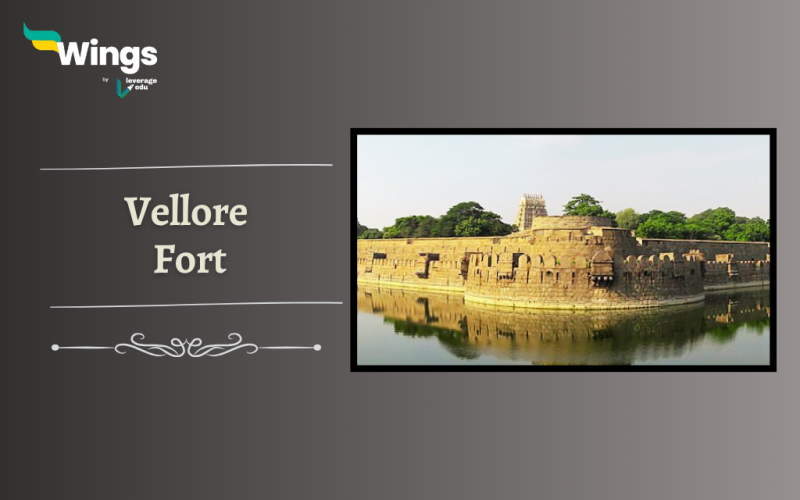Vellore Fort is located in the city of Vellore in Tamil Nadu, India. It is a historic monument that has withstood the test of time and has seen various events under various dynasties to tell the story of its glorious past and the architectural prowess of its builders. Originally constructed during the 16th century, this fort has witnessed centuries of history unfold within its massive walls. Let’s delve into the Vellore fort history, features and facts that surround this iconic structure.
Table of Contents [show]
| Commissioned by | Chinna Bommi Nayak |
| Also Known as | Vellore Mutiny Fort |
| Location | Osmanabad, Maharashtra |
| Timings | Open 8:00 AM to 6:00 PM on all days |
| Entry Fee for fort | Rs -10 |
History of Vellore Fort
- The construction of Vellore Fort began in the year 1566 under the reign of the Vijayanagara Empire.
- Chinna Bommi Nayak is believed to be the ruler under whose patronage the fort was built.
- After the Batte of Talikota, the fort came to prominence in the Vijaynagar region which was ruled with Chandragiri as the 4th capital of the kingdom.
- It was later captured and enhanced by the Bijapur Sultanate in the early 17th century.
- In 1678, after a long fourteen-month siege, the fort came under the control of the Marathas under the leadership of Chhatrapati Shivaji Maharaj, who further fortified its defences.
- Over the years, the fort saw several renovations and additions, with each ruler leaving their mark on the structure from Mughals to the Nawab of Arcot and his relatives till the year 1733.
- The British East India Company took possession of Vellore Fort in 1760 and used it as a stronghold during various wars and uprisings.
- During the British colonial era, Vellore Fort served as a strategic stronghold and later as a prison for captured freedom fighters.
- The Fort also witnessed the scenes of Vellore Sepoy Mutiny of 1806 also called, the Vellore Mutiny.
Features of Vellore Fort
- The fort is spread over an area of 133 acres and is surrounded by a deep moat that serves as a protective barrier.
- It boasts a unique architectural blend of Dravidian, Indo-Islamic, and European styles, reflecting the diverse influences of its builders.
- Within the fort, you can find several notable structures such as the Jalakanteswarar Temple, St. John’s Church which was built by Robert Clive, and the Vellore Government Museum.
- It also houses Tipu Mahal, Begum Mahal and Kandi Mahal and is all carved out of granite stones.
- The fort also houses a prison that gained notoriety during the Indian Uprising of 1806, when British officers were attacked and killed by sepoys.
Also Read – Harihar Fort History: Features, Facts, Timings & More
Facts of Vellore Fort
- Did you know? that Vellore Fort is believed to have been constructed using a unique mortar made of egg whites and lime.
- The fort is also famous for its double-walled construction, which provided added protection against enemy attacks.
- Vellore Fort was the site of the infamous Vellore Mutiny in 1806, a rebellion by Indian soldiers against the British East India Company.
- It served as a residence for various rulers and dignitaries over the centuries, including Tipu Sultan and the British Governors.
Also Read – Janjira Fort History: Features, Facts, Timings & More
Timings and Entry Fee of Vellore Fort
The timings for visiting the Monument and watching the mesmerising scene are –
| Purpose | Timings |
| Entry | 8 am to 6:00 pm |
| Week Entry | Everyday |
| Entry Fee | Rs 10 |
In conclusion, As we reflect on the storied past of Vellore Fort, we are reminded of the enduring legacy of this magnificent structure. From its humble beginnings as a Nayak stronghold to its role in standing for the countries freedom, this fort stands as a silent witness to the passage of time.
Other Attractions near Vellore Fort
| Sripuram Golden Temple | Periyar Park |
| Virinjipuram Temple | Palamathi Hills |
| Tipu and Hyder Mahal | Kaigai Falls |
| Jalakandeswara Temple | Punganur Lake |
| Gingee Fort | Arcot |
| Amirthi Zoological Park | Thiruparkadal |
Relevant Blogs
That’s all about Vellore Fort history! If you want to know more about topics like this, then visit our general knowledge page! Alternatively, you can also read our blog on general knowledge for competitive exams!
 One app for all your study abroad needs
One app for all your study abroad needs















 45,000+ students trusted us with their dreams. Take the first step today!
45,000+ students trusted us with their dreams. Take the first step today!
